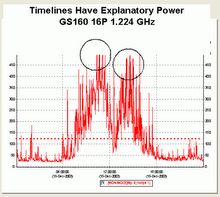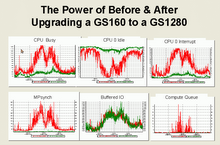One of the big treats for me at this year's bootcamp was learning more about the latest versions of the powerful PerfDat performance tool. Even more special was that the developer, Dr. Wolfgang Burger (HP Austria), was there to present it in person in what I considered a virtuoso performance - demonstrating dozens of features and capabilities in a few short hours.
If you care about performance on OpenVMS, and if maintaining performance that meets your service level objectives and requirements is essential, then I believe you will want to learn more about this exceptional and wide-ranging piece of software and consider adding it to your repetoire.
That's exactly what I plan to do myself. I see PerfDat as another tool to complement my growing arsenal of tools that I can then use individually or in combination to tackle the toughest performance challenges.
In particular, it looks like PerfDat is going to play extremely well together with T4. This stands in contrast to what might be considered similar performance tools on the market that do not integrate as well with T4.
For example, PerfDat make it possible to easily upload any T4-style history data you have created into its internally managed database. This means that you can apply PerfDat's powerful database capabilities for selecting data from a long term history. Then use its excellent trend graphing features, easily creating charts that show weeks and months of history.
If you are a fan who appreciates the benefits of the T4 approach, I believe that you will find PerfDat very much to your liking. Within the single tool, it includes features and functions that make it look like a combination of the T4 Collector in History mode, major portions of TLViz' ease of looking at trend data, and significant parts of CSVPNG's ability to manipulate CSV files.
PerfDat will further integrate with the T4 approach since it is possible to select data and then output that data as a 2 dimensional table in T4-style format. These could then be fed into TLViz or CSVPNG so as to take advantage of the continuing strengths of these tools for handling data that is local to your PC.
If you would like more information, a great place to start is this PerfDat - OpenVMS Technical Journal Article. Trial versions of the software kit for OpenVMS, the GUI that runs on Windows, and a full set of documentation can be downloaded from http://hpperfdat.compinia.com/
You'll notice when you get to the download page that the headline is:
HP PerfDat - for people whose time is precious !
So, you won't be surprised why someone who has been talking about the time-saving T4 approach for so many years might be interested. In my eyes, PerfDat, is a new generation in a growing line of Time-saving Trend Tracking Tools that will prove extremely helpful in situations where maintaining proper performance is of mission critical concern.
Showing posts with label time-saving. Show all posts
Showing posts with label time-saving. Show all posts
Sunday, June 3, 2007
T4 Sessions at BootCamp - The Many Faces of T4 continued
Thanks to Pat McConnell (OpenVMS Engineering) for orchestrating and organizing the two half- day T4 sessions at this year's OpenVMS Technical BootCamp.
Bootcamp attendees were able to see and hear examples of different ways of applying a T4 approach to their particular performance problems.
Here's a list some highlights of these two sessions. If you would like more information about any of these topics, you can contact me here.
The first main thought that came across to me after watching all these individual segments (not to mention the additional material from the special T4 projects workshop) was the ease at which the T4 universe of tools could be readily adopted to the strengths and interests of the person using these tools and the type of problem they are trying to solve.
Each person's approach was both different and effective. I am hoping that those attending the bootcamp were able to come away with a number of new ideas for a mix of styles that they can add to their personal T4 repertoire.
The second major thought from watching all these different approaches was that in each case, the T4 tool set had directly unlocked significant time-savings for doing the performance work at hand. This of course is consistent with the design center for the T4 approach which has always been and still remains focused on saving our time. T4 always treats our time as the scarcest, most precious resource.
Bootcamp attendees were able to see and hear examples of different ways of applying a T4 approach to their particular performance problems.
Here's a list some highlights of these two sessions. If you would like more information about any of these topics, you can contact me here.
- Pat McConnell demonstrated how easy it is to install T4 and get it up and running
- Kevin Jenkins walked us through a series of challenging examples and showed us how he uses TLViz to dig into the toughest problems.
- Tom Cafarella gave us an update on the latest developments with T4 V4.2
- Melanie Hubbard brought us up to date on the latest developments with OTLT - the Oracle Time Line Tool including how to acquire the most recent version from Oracle Metalink
- Bart Lederman shared his system manager experience of putting T4 into practice in a very large computer center with literally dozens of OpenVMS systems. He focused on how he step by step augmented the out of the box capabilities of T4 by customizing the DCL scripts, adding automation to avoid repeating the same steps on each system, and adding a series of very useful new T4-style collectors.
- John Fisher illustrated how he used the most advanced features of both TLViz and CSVPNG to tackle really complex problems involving OpenVMS and EVA storage.
- Steve Lieman presented on the latest improvements to TLViz and CSVPNG and how these are focused on saving our time.
- While we ran out of time to present it, BootCamp attendees were able to download a copy of Pat McConnell's excellent presentation showing what is required to create new T4-style CSV files that will work well with TLViz and CSVPNG.
The first main thought that came across to me after watching all these individual segments (not to mention the additional material from the special T4 projects workshop) was the ease at which the T4 universe of tools could be readily adopted to the strengths and interests of the person using these tools and the type of problem they are trying to solve.
Each person's approach was both different and effective. I am hoping that those attending the bootcamp were able to come away with a number of new ideas for a mix of styles that they can add to their personal T4 repertoire.
The second major thought from watching all these different approaches was that in each case, the T4 tool set had directly unlocked significant time-savings for doing the performance work at hand. This of course is consistent with the design center for the T4 approach which has always been and still remains focused on saving our time. T4 always treats our time as the scarcest, most precious resource.
Subscribe to:
Posts (Atom)


